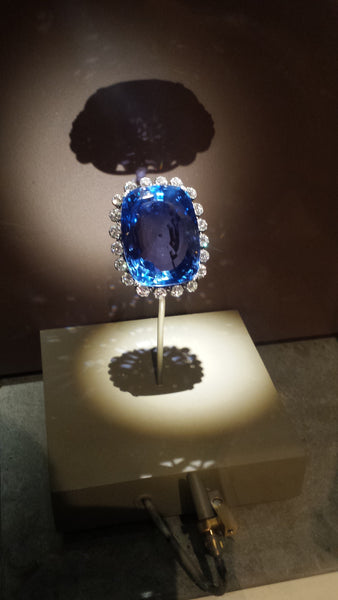The Logan Sapphire October 09 2015
The epitome of the skill and mastery of Sri Lankan gem cutting is embodied in a gemstone known as the Logan Sapphire.
This elegant blue sapphire, which is of Sri Lankan origin, is the second largest gemstone in the world weighing in at 422.99 carats (84.6 grams) and is currently housed in the Smithsonian National Museum of Natural History in Washington D.C, USA.
The Logan sapphire was donated to this museum by Mrs. John Logan in 1960 and can be found in the gem gallery in between the Bismarck sapphire necklace and the Hall sapphire and diamond necklace. The Logan emanates a lush cornflower blue as it is set in a silver and golden brooch framed by twenty round diamonds that add a brilliant aura around it. After being examined by the Gemological Institute of America in 1997, has been declared completely natural with absolutely no heat treatment to enhance its color. In its natural state, it radiates its beauty through its flawless internal structure and perfect clarity. The master gem cutter had a clear vision of the value propagated by this incredibly rare gemstone and hence featured a precise cushion cut with a large table to allow admirers to view the flawless interior of this extraordinarily large sapphire.the Logan sapphire
The Logan emanates a lush cornflower blue as it is set in a silver and golden brooch framed by twenty round diamonds that add a brilliant aura around it. After being examined by the Gemological Institute of America in 1997, has been declared completely natural with absolutely no heat treatment to enhance its color. In its natural state, it radiates its beauty through its flawless internal structure and perfect clarity. The master gem cutter had a clear vision of the value propagated by this incredibly rare gemstone and hence featured a precise cushion cut with a large table to allow admirers to view the flawless interior of this extraordinarily large sapphire.the Logan sapphire
The entire history of this gemstone is not exactly clear. The best estimates date the mining of this precious stone to the early 19th century. After being cut by the ancient Moors of Sri Lanka, who often emphasize the ‘quantity’ aspect of gems, it was exported to Paris to be sold at a gem and jewelry auction. One notable owner who purchased this gemstone was the Guggenheim family who operated the American Smelting and Refining Company (ASARCO). It was the Robert Guggenheim that helped open the Hall of Gems and Minerals at the Smithsonian Museum but as he passed away, his wife Mrs. Logan, donated the gemstone to the museum as a tribute to her loving husband.
The Logan sapphire is indeed a masterpiece of Nature’s creations. Its journey from mine to museum has seen decades of love, compassion and dedicated craftsmanship. As it sits in the revered halls of the Smithsonian, we can be rest assured that it will continue to spark awe and admiration upon those who appreciate its natural perfection.
